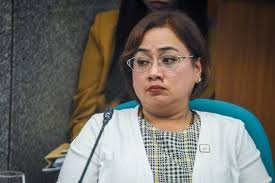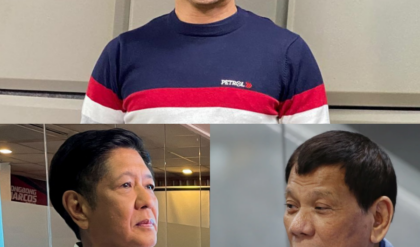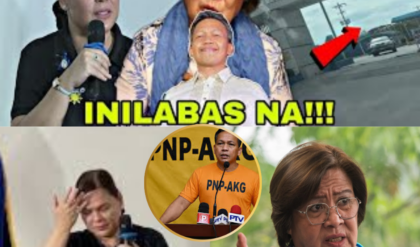A day of startling revelations unfolded at the Senate as a high-ranking official, long whispered to hold significant influence over the nation’s flood control projects—dubbed by observers the “Flood Control Queen”—faced a blistering public inquiry. Over more than two tense hours, deep-seated corruption surrounding allocated flood mitigation funds was systematically exposed, triggering a volatile mix of shock, public fury, and fleeting sympathy.
The session began with the official maintaining an air of control and composure. However, the atmosphere in the chamber shifted dramatically when Senate investigators introduced irrefutable documentation: contracts, receipts, and bank statements bearing her name and signature. A heavy silence descended upon the hall, every eye fixed on the official. She visibly struggled to maintain her composure, repeatedly bowing her head and nearly breaking into tears as each line of the report laid bare the details of billions of pesos allegedly funneled away from public works.

Ghost Projects and the $10 Billion Question
The investigative reports revealed a shocking pattern of fraud: numerous essential flood control projects were officially approved but were never completed. Furthermore, documents existed that falsely certified some projects as “fully accomplished,” yet site inspections revealed nothing but barren, muddy lots. The official’s direct signature on these fraudulent completion papers suggested an undeniable and direct nexus to the missing funds.
Amidst sharp questioning from senators, particularly concerning the destination of an estimated ₱10 billion (approximately $170 million USD) in diverted funds, her response was weak and evasive: “I don’t know, Sir.” For the senators and the observing public, her denial only underscored the gravity of what she was desperately trying to conceal.
The Digital Trail: Emails, Transactions, and the Corrupt Network
The scandal’s reach extends far beyond paper documents. Investigative sources disclosed that the probe is actively examining a trove of emails, bank transactions, and text messages that could potentially implicate officials occupying much higher offices. It is alleged that the flood control projects were systematically used as financial “fronts” to facilitate the transfer of colossal public funds to private corporations with deep-seated political ties.
Under the crushing weight of relentless scrutiny, the official ultimately broke down in tears, repeatedly claiming that she was merely “dragged into the scheme” and made a “sacrificial scapegoat” by the system. This tearful defense immediately polarized the public: Was she a primary perpetrator or merely a subordinate victim caught within a much larger, more pervasive network of corruption?

Public Fury and the Senate’s Vow of Relentless Pursuit
As the harrowing details circulated, social media exploded. Hashtags like #FloodQueenExposed and #SenateLeak trended, drawing thousands of online commentators fueled by anger and a hunger for justice. While many demanded immediate accountability for those who had profited from disaster mitigation funds, others expressed a weary cynicism, questioning who the true beneficiaries of the stolen billions really were.
The tension culminated when one senator dropped a bombshell statement: “Flood control is just the beginning. There is a deeper and far more extensive network that must be exposed.” This declaration was followed by a frenzy of activity as new documents were presented as evidence—including names, transactions, and additional project details that could potentially lead to numerous plunder charges and sweeping administrative sanctions against top-tier officials.
The investigation has revealed a consistent pattern suggesting the corruption transcends any single individual. The use of flood mitigation funding to enrich private companies owned or controlled by political figures suggests a deeply entrenched system where the “Flood Control Queen” serves merely as a highly visible symptom of a decades-old institutional rot.
The Senate has signaled its unwavering determination: the inquiry will not cease until the full scope of the conspiracy is uncovered. Media organizations, public finance experts, and vigilant citizens remain glued to the proceedings, ready to dissect every line of emerging evidence.

The Gathering Storm: Accountability and the Future of Governance
The spectacle in the Senate was far more than a simple hearing; it was a high-stakes political drama embedded within a scandal poised to rock the nation’s entire governance structure. The palpable tension in the chamber felt like the calm before a major storm—a signal that the fallout could engulf not just one official, but the whole political system.
Crucial questions now dominate the national conversation: Who will be the next to face justice? Who truly masterminded the large-scale diversion of funds meant to protect citizens from yearly floods? And how long will this corrupt system endure before accountability finally dismantles it?
The release of the contracts, documents, and banking records is merely the initial phase of an intensive investigation that may expose one of the largest corruption scandals of the decade. This unfolding narrative of stolen money, abused power, and betrayal underscores the profound complexity of the nation’s endemic corruption problem.
In the end, the image of the “Flood Control Queen” and her tears serves as a powerful, haunting symbol: a stark reminder that in every public project, every fund allocation, and every official decision, there is an ultimate responsibility. The storm that is gathering does not just reflect one official—it represents the long-overdue, enduring challenge to achieve justice and transparency in national governance.





